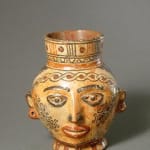Terracotta Trophy Head, 500 CE - 800 CE
Terracotta
7.5
PF.4264
To the Costa Ricans, human head effigy vessels represented a prisoner of war or a sacrificial victim. These vessels are known as trophy heads. The artist's craftsmanship captures the realistic...
To the Costa Ricans, human head effigy vessels represented a prisoner of war or a sacrificial victim. These vessels are known as trophy heads. The artist's craftsmanship captures the realistic nature of this piece. The artist took considerable time to depict the exactness of this victim. The face is very distinguished and carefully painted. The eyes are almond shaped highlighted in black paint and incisions were made around the eyeballs. The idea of the artist was to dramatize the fear and pain of this individual. There are beautiful tribal markings on the face. Around the forehead is a twisted rope pattern in black with red dots in the center. The cheeks have another pattern done in the same intensity and beauty as the pattern on the forehead. Close attention should be paid to the nose and mouth. The nose is elegantly carved and the nostrils are painted black enhancing the effect of a nose that flares out in pain. The mouth is partially opened and the lips are in a pouting expression as if this person is gasping for air. The effect depicts surprise on his face. The hairline begins behind the ears that are adorned with ear disks. The base of this piece was designed to look like a neck. The pattern is of red vertical lines outlined in black. The top portion of the vessel is painted in traditional tribal markings in a repetitious pattern.



